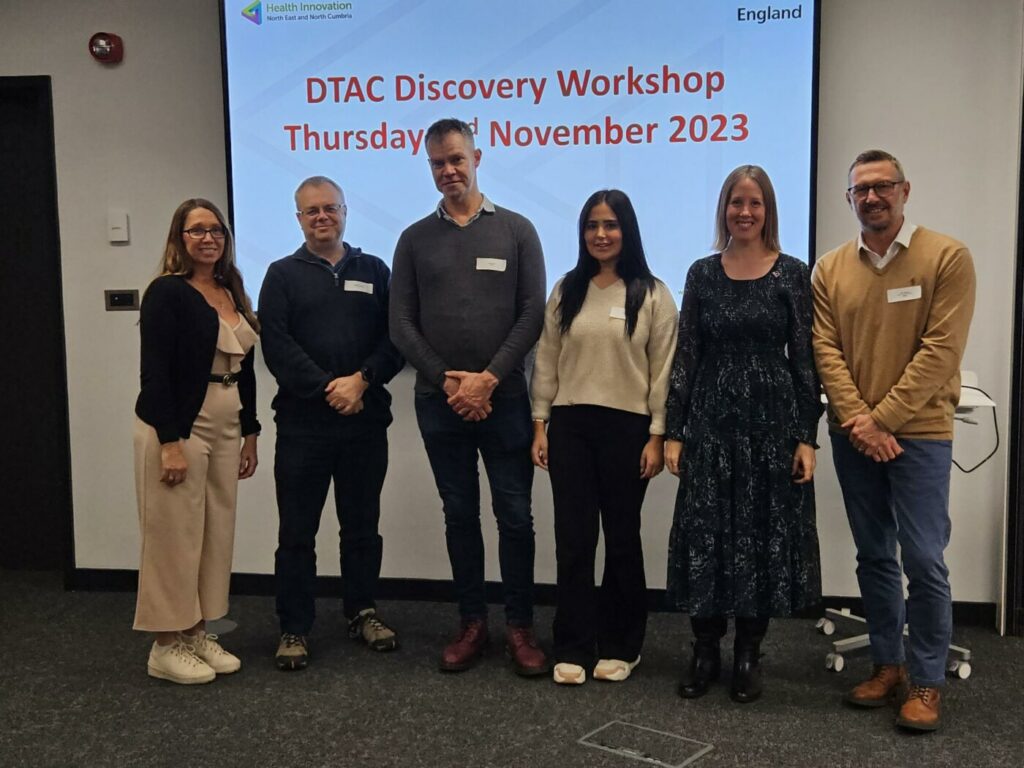At Health Innovation North East and North Cumbria (HI NENC) we recently brought together local companies who all have transformative, new innovations that we are supporting to provide into the NHS. Launching a new innovation into the NHS is not easy, and at HI NENC we specialise in supporting innovators, whether they come from a clinical or commercial background.
Selling digital services into the NHS comes with a range of challenges, including being compliant with Digital Regulation and the Digital Technology Assessment Criteria – or DTAC. This was the focus of a recent event we hosted at the Catalyst in Newcastle.
We invited several innovators we have been working with to help guide them through the DTAC process. The session, which included expert speakers from NHS England’s DTAC Team, was also an opportunity for the innovators to network and learn from one another.
In this blog, NHS England’s Katharine North talks about the workshop event and the DTAC Readiness Tool.
The DTAC Team; Sonal Bhalla, Paul Hudson and I were invited to attend the DTAC Navigating the changing regulatory landscape Workshop in Newcastle. It was expertly arranged and run by the Health Innovation North East and Cumbria Team. I had been working with Rachael Forbister to develop the DTAC Readiness Tool and the workshop was a wonderful opportunity to ask innovators to evaluate the tool and provide feedback so it could be improved.
The event began with a warm welcome from Dave Belshaw who explained the original purpose of DTAC, to provide a framework for those procuring digital health technology and its journey to an essential set of criteria for innovators. He introduced the idea behind the Readiness Tool, for innovators to self-assess and identify gaps. He asked attendees to function as critical friends, to give their honest feedback on the tool.
We were then treated to a profoundly powerful presentation by Dr Jonathan Harness from his perspective as a GP and a Clinical Safety Officer. He explained technology was an enabler and should allow things to be done better, safer, and more efficiently. But he also gave examples of when technology goes wrong, that it has the potential to cause harm. His passion for DTAC shone through, he spoke from the heart about DTAC being vital to avoid this. He cited medical ethics and the first law of robotics being do no harm. Explaining that when things went wrong it was usually a result of technology not being used as intended or being too difficult to use. He talked about trust and confidentiality being at the heart of medicine, the need to protect the most intimate information about a patient.
The DTAC Team went next, Paul began with a helpful analogy, DTAC being the digital equivalent to the car MOT. Sonal went on to explain the individual components of clinical safety, data protection, technical assurance, interoperability, useability, and accessibility. I then spoke about the process, completing the DTAC document, gathering the evidence, providing it for review by the procuring team and then the ongoing process of penetration testing and maintaining certification. I ended with answers to common questions. We then began the most exciting and challenging part of the day, opening the floor for questions. The depth and breadth of the queries we receive always astounds me, mirroring the depth and breadth of technology innovators are developing.
It was then time to trial the tool. The team and I made ourselves available for further queries as innovators completed the questions. Useful feedback was then gathered, highlighting some adjustments and clarification required. There is further work to do but it was clear that the tool worked, innovators found it useful acting as a clear gap analysis.
Today is bittersweet for me, tomorrow being my last day within the DTAC Team. I am moving on to pastures new. I have thoroughly enjoyed my time within the team, working with innovators and procurement teams alike. DTAC will always have a part of my heart and as I continue to work in the digital space it will always be in the forefront of my mind. I hope the DTAC Readiness Tool will leave a lasting legacy in continuing to help innovators meet these most important standards.
On a final note, I have only been to Newcastle once, it rained then and today was no exception. We were at the mercy of Storm Ciarán which created travel disruption for attendees. Only the determined would make it there and some had disruption travelling home. Was it worth it? For me…absolutely.
What others involved in the day thought
“There was a strong focus on ensuring those in attendance left the workshop with a suitably greater understanding of DTAC regulation than they arrived with; supplemented by the provision of the ‘DTAC Readiness Tool’. As a company, we are now better prepared to assess our compliance with the DTAC and initiate the regulatory process.” – Alex at Manus Neurodynamica
“This session was a great opportunity to delve deeply into the world of digital regulation. It can be a big challenge for innovators to navigate through this complexity, so we wanted to offer them the chance to work with our team of experts to guide them through.” – Dave Belshaw, Digital Transformation Director at HI NENC
HI NENC specialises in providing expert help and guidance for innovators looking to market products or services in health or care services. We provide support to NHS or industry innovators across the region and are also leading the Healthtech sector as part of the Digital Cluster North of Tyne Programme for businesses in Newcastle, North Tyneside and Northumberland. This project is delivered in partnership with Innovation SuperNetwork and Dynamo North East and funded by the North of Tyne Combined Authority.

